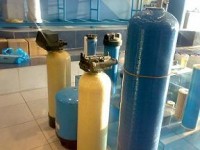

WATER HARDNESS
Temporary and Permanent Hardness
For convenience, hard water is classified as
- Temporary Hardness and
- Permanent Hardness
Temporary Hardness:
Temporary hardness is due to the presence of soluble bicarbonates of calcium, magnesium and iron in water.
Permanent Hardness:
Permanent hardness is caused by the presence of the chlorides and sulphates of calcium and magnesium in the water as chlorides and sulphates.
Removal of Temporary hardness:
Temporary hardness can be removed by:
- Boiling
- Clarke’s process
Boiling
When the soluble bicarbonates are converted into insoluble carbonates which are precipitated and CO2 is evolved.
Ca (HCO3)2 CaCO3 + H2O + CO2
Mg (HCO3)2 MgCO3 + H2O + CO2
Fe (HCO3)2 = FeCO3 + H2O + CO2
(4FeCO3 + 6H2O + 4Fe(OH)3 + 4CO2)
While CaCO3 and MgCO3 form white powdery precipitate, iron is precipitated as slimy brown precipitate of Fe(OH)2. Magnesium bicarbonate hardness is not fully removed by boiling, as MgCO3 is appreciably soluble in water compared to CaCO3.
Clarke’s process
Temporary hard water is softened for industrial purposes by adding the calculated quantity of slaked lime which precipitates the insoluble carbonates.
Ca(HCO3)2 + Ca(OH)2 2CaCO3 + 2H2O
Mg(HCO3)1 + Ca(OH)2 MgCO3 + CaCO3 + 2H2O
The MgCO3. which is appreciably soluble, then reacts with further quantity of Ca(CH)2 to form insoluble Mg (OH)2
MgCO3 Ca(OH)2 = Mg(OH)2 CaCO3
Mg(OH)2 is sparingly soluble and hence removed.
Slaked lime must be added in extremely calculated quantities, as any excess of Ca(OH)2 present in the softened water would again cause hardness. The mixing of lime and water is done in large settling tanks. After the precipitates have settled down, the clear soft water is pumped to reservoirs for distribution.
Removal of Permanent Hardness:
Permanent hardness of water is caused by the presence of the chlorides and sulphates of calcium and magnesium in the water. While temporary water hardness can be removed by boiling or adding lime, permanent hardness cannot be removed by those processes since such methods do not precipitate the calcium or magnesium of hard water.
Permanently hard water is softened by the addition of Na2CO3 to water, when insoluble CaCO3 and MgCO3 precipitate. The insoluble carbonates can then be removed by filtering through a water treatment filter process.
CaSO4 Na2CO3 = CaCO3 Na2SO4
MgCl2 Na2CO3 = MgCO3 2NaCl
It must be noted that along with the chlorides and sulphates of calcium and magnesium (permanent hardness), there are also present the bicarbonates in some quantities (temporary hardness. Hence method or methods capable of removing both types of water hardness is adopted.
3 Responses to “WATER HARDNESS”
Leave a Reply







 LIKE TO GET UPDATES
LIKE TO GET UPDATES  TO GET EXPERT GUIDE
TO GET EXPERT GUIDE
thank you
dear sir,
My all data attach with my cv.if you have any job related r o water plant & pump section .please hire me i have too much experience for this.i completing b.tech (mechanical) from preston univresty islamabad.waiting result. i working in saudi oger pvt ltd (operation and maint) as a 1st technician mechanical in r o water treatment plant in pump section .my job here is responsible .i have
good knowledge related pump and water plant.you can asked me any question .my contract finish in march 2012 with saudi oger pvt ltd.
if you give me a chance i shall be very thanks full to you for this.
i waiting your answer.
thanks, .
thanks a lot